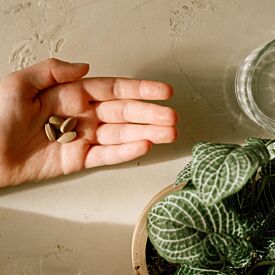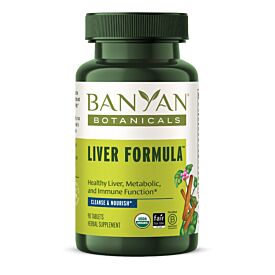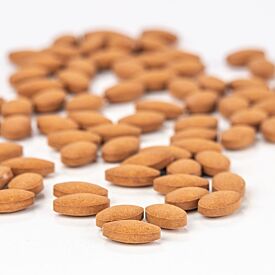The Hair and Bone Connection
We often look at our hair as a beauty statement or as a way to express our personality. We may want our curls to bring on a fun and adventurous look, or gloss our straight hair for a clean shine. But Ayurveda would encourage you to look deeper at your hair, as it can say so much about what is going on inside your body, particularly the bone tissue (asthi dhatu).
In Ayurveda, it is said that hair is a byproduct of the asthi dhatu. It is an inferior byproduct, meaning that it acts like a waste product of the tissues with changes in its nature based on imbalances of the asthi dhatu. The other inferior byproduct of asthi dhatu are the nails, and the superior byproduct, or a more refined byproduct of this tissue, are the teeth.
Unlike the teeth, hair and nails do not have any nerve endings. Like asthi dhatu, the hair is mostly earth and water elements, and has much in common with kapha in terms of its innate composition.
Hence, the strongly kapha individual will often have thick and lustrous hair. The thin vata individual often has dry and brittle hair. And the pitta individual may have thin or fine hair with early graying. Then, of course, there are variations in between based on other characteristics of the constitution and the individual’s imbalance.
By looking at an individual’s hair, we can tell much about the health of asthi dhatu. For instance, new, excessive hair growth, may be a sign of excessive growth of bone tissue (asthi vruddhi), which may manifest as bone spurs and spinal misalignments from overgrowth of the tissue. Hair loss, on the other hand, can be a sign of decreased asthi dhatu (asthi kshaya), which may manifest as thinner bones that have a greater propensity towards fractures.
It is important to take note of these subtle changes in the hair and how they connect with deeper tissues. The states of asthi vruddhi and kshaya are telling signs of the state of the agni of asthi dhatu (asthi agni). When it is hyperactive, the tissue in essence burns away, causing the state of asthi kshaya (depletion). The opposite is true when the agni is hypoactive.
As we know, agni is intricately connected with the thyroid. If the thyroid is hyperactive, the agni becomes hyperactive, and the bone tissue dwindles as the hair begins to fall out. In this way, the state of the bones is often opposite of how active the agni is.
While the overall composition of the hair can tell us so much about the bones and thyroid, we can look even further at other connections within the body by looking at the color of the hair and the oiliness of the hair. Herein lies the connection between the hair, pitta dosha, and pitta organs of the body, such as the blood and liver. Excessive pitta causes early graying of hair (the color turns to the color of ash, so to speak).
Before that occurs, however, the excessive pitta will cause more oil, which is one reason pitta individuals need to wash their hair more frequently. There may be so much pitta that the hair follicle is burnt out, causing hair loss. In this way, you can tell whether the hair loss is due to high pitta (there is early graying and more oiliness) or hyperactive agni often due to high vata (more dry hair).
How to Use This Information
- First ask, what is the composition of the hair like? If it is dry and brittle, you can be sure there is hyperactive metabolism and vata imbalances. If it is thick and lustrous along with other kapha signs in the body, you may find hypoactive metabolism and kapha imbalances.
- Then ask, are there signs of excess pitta, such as oiliness and early graying, or balding especially around the temporal region of the skull? If this is the case, tune into whether there are other signs of high pitta that need to be cleansed from the blood, or the liver if it is long-standing. Consider Blood Cleanse for excess pitta in rakta dhatu, or Liver Formula if the imbalance has moved to the seat of ranjaka pitta—the liver.
- Support agni based on the composition of the hair. If there are signs of high vata and excessive metabolism, bring in vata pacifying diet, lifestyle practices, and herbs. Consider Nadi Shodhana pranayama, yoga nidra (emphasizing sleep), and herbs like ashwagandha and those found in Healthy Vata. By grounding the body, the thyroid will sense less of a need to be on “overdrive,” as will the adrenal glands. If there are signs of high kapha and hypoactive metabolism, boost the agni with stimulating herbs and practices such as pranayama, yoga, and herbs like ginger and Kapha Digest.
- Support the bone tissue. If there are signs of vata imbalances, support the hair and bone tissue with Healthy Bones tablets.
- Support the hair to its finest state. Products like Healthy Hair tablets and Healthy Hair Oil work on multiple levels. And the herbs they contain, like bhringaraj, brahmi, and amalaki all cleanse pitta, which strengthen the color and roots. These herbs are also calming and cooling to the mind, which stabilizes vata and the tendency to always be on-the-go.
It is easy to look at a part of the body separate from the whole, as is the case with hair. But the wisdom of Ayurveda helps us use it as a window to deeper parts of the whole body.












